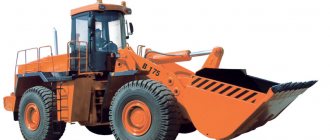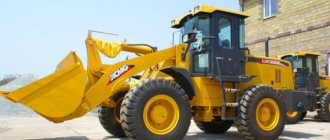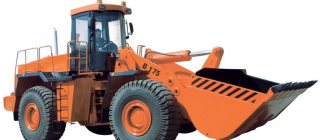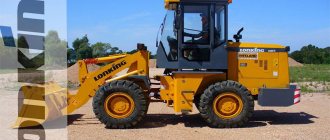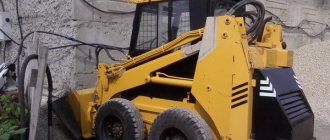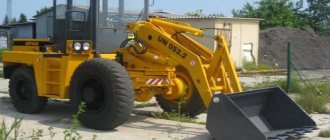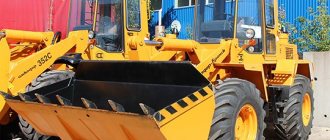Backhoe loaders of the Terex brand are manufactured by the international corporation Terex, which specializes in the production of various types of special equipment and has more than 50 enterprises around the world, including in the USA, Great Britain, Germany, etc. Over its almost hundred-year history, this brand has gained wide worldwide fame and popularity, including in our country.
Purpose and scope of use
A backhoe loader is a multifunctional unit on a self-propelled wheeled chassis, the executive equipment of which allows for excavation work, transportation, unloading and loading of cargo. The unit is effective when maintaining:
- earthmoving operations;
- when constructing foundation pits, forming ditches and trenches;
- works on site planning;
- loading excavated soil into vehicles;
- distribution of backfill materials throughout the construction site;
- moving cargo in a front bucket over short distances;
- towing trailers with cargo.
The canopy unit allows for quick replacement of the front bucket with interchangeable devices (grab loading devices, hydraulic hammer, vibratory rammer, drilling equipment, hydraulic shears, etc.), which increases the versatility of the machine.
Backhoe loader Terex 860
Buy a Kamaz or buy a Volvo - which dump truck is better?
To the question: which is better: Kamaz or Volvo - the answer cannot be unambiguous. But despite this, a choice still has to be made. Only one thing is certain: ideal dump trucks do not exist. Sooner or later, everyone is subject to breakdowns and malfunctions: both Russian KamAZs and foreign Volvos.
Undoubtedly, there are more problems with domestic cars, and their commercial efficiency does not differ in the same power as when using foreign cars. But countless service centers are willing to take care of Kamaz trucks, which often break down, while there are not so many Volvo repair specialists in our country. This circumstance to some extent equalizes the scales between domestic and foreign brands. Consumables for Kamaz trucks can be purchased at an affordable price, while spare parts for Volvos are not affordable for every owner. The advantage of using a Russian car is that, if you have the desire and knowledge, you can repair the dump truck yourself, without resorting to the help of service showroom specialists. The situation with Volvo is different: spare parts for them cannot always be found in stock in car shops and warehouses, and repairs are completely impossible without the involvement of a qualified mechanic.
What characteristics is Kamaz famous for? Load capacity 20 tons, body volume 12 cubic meters, “native” engine with a power of 320 hp
So it seems, what else is needed? However, Russian transport companies involved in the transportation of goods try, whenever possible, to focus attention on foreign innovations of the same Volvo
How to explain this? The fact is that the payload capacity of foreign cars is often significantly higher than that of Kamaz trucks, and with the same fuel costs, Volvos can carry out larger-scale transportation than domestic dump trucks. Transport companies understand how tangible the benefits of using “foreign” vehicles for commercial purposes are. The advantage of foreign Volvo trucks is the good capacity of the bodies and the presence of heating. The latter, in fact, eliminates problems associated with the safety of transported goods.
Another reason why transport companies favor foreign Volvo dump trucks more than KamAZ trucks is that they are equipped with a wide range of additional devices that simplify the operation of these vehicles. However, it is worth understanding that if the “foreigner” is not adequately prepared for sale, it is prone to breakdowns already during the first time of operation. As for the manufacturer's guarantee for their products, ours and foreigners provide approximately the same warranty period for operational service - 12 months from the date of purchase. And dealerships agree to extend this period only on a paid basis.
In the eternal debate between carriers about what is more suitable for Russian roads - Kamaz or Volvo - the wisest answer is: work in the quarry will show. This is where no amount of advertising with Van Damme showing off the splits between two imported trucks will help. At the quarry you can see firsthand the strengths and weaknesses of Russian and foreign dump trucks.
What are the differences from similar machines
- Coordinated parameters of the power plant, gearbox and hydraulic system ensure high machine efficiency, short work cycles, and smooth movement of the executive bodies.
- High transport speed, permission to travel on public roads. Safety in motion is achieved by a duplicated brake drive on all wheels and reliable locking of the Terex 860 excavator boom.
- When driving on rough terrain, a device is used to ensure a smooth ride to grip the wheels with the soil and stabilize the position of the loader bucket.
- Large ground clearance prevents damage to components in the lower part of the body.
- The cross-country ability and maneuverability of the unit are determined by a lockable differential device in the rear axle and separate wheel braking on the sides (two brake pedals with an articulation device).
- The model with the SX index is equipped with a backhoe boom column that can be moved longitudinally on board.
Must Read: Merlot Telehandler
Engine
The Terex TL150 loader is equipped with a Russian-made YaMZ 530 power unit, which is characterized by:
- Power Boost system;
- possibility of starting at negative temperatures;
- low noise;
- economical in terms of fuel consumption (213.5 g/kWh).
The engine power is 140 kW and the volume is 4.43 liters. It is capable of operating at a nominal speed of 2300 rpm and 750-850 at idle. The cooling system turns on automatically, which prevents the engine from overheating. For this purpose, together with the four-cylinder unit, the following are provided:
- single block of radiators with diffuser, fan and Terex TL 150 hydraulic motor;
- electrical control that works with temperature sensors;
- adjustable axial piston pump.
Advantages of the power unit:
- automatic quality control of the system;
- emergency mode;
- economic efficiency;
- minimal amount of noise during operation;
- high-quality heat dissipation.
The standard assembly is equipped with a Teplostar TS14-mini pre-heater with a power of 14 kW.
Return to navigation
How the car works
Main components and assemblies
1 – front bucket loading device; 2 – boom-traverse; 3, 5 – driving axles; 4 — battery box; 6 – control cabin; 7 – power plant hood; 8 – boom of excavator equipment (backhoe); 9 – handle; 10 – excavator bucket device; 11 – boom transverse displacement carriage; 12 – outriggers; 13 – fuel tank; 14 – hydraulic fluid tank.
Power plant. In-line, longitudinally arranged 4-cylinder turbocharged diesel engine Perkins 1104D-44T with a power of 74.5 kW per volume of 4.4 liters. the maximum power torque is produced at 1400 rpm and is 392 Nm. Synchro Shuttle transmission. A one-stage two-phase torque converter and a 4-stage gearbox equipped with servo drives provide 4 forward and 3 reverse modes of torque transmission. Rear axle. Drive, built-in differential with full blocking, gear units in planetary design, brake discs in an oil bath. The differential and brakes are controlled by pedals from the cockpit. Front axle. Connectable with independent suspension. Brakes. Disc on the rear axle shafts with hydraulic control. Steering. Hydrostatic circuit at a pressure of 175 bar. Pneumatic wheels. Front - 16/70x20, rear - 16.9x20. Hydraulic system. Twin gear pumps with a total flow of 160 l/min and a pressure of 225 bar. Control via a closed-type three-spool device. Buckets. Frontal multi-purpose - 1.2 m3 with a width of 2.386 m. Backhoe - 0.286 m3 with a width of 0.9 m. Cabin. Equipped with protection against falling objects FOPS and against the consequences of overturning ROPS. Installed ventilation and heating units, seat and steering column adjustment devices provide fairly comfortable working conditions.
Terex 860 cabin
Telescopic
Terex telehandlers include:
- GTH-2506;
- Girolift 3518;
- GTH-3713.
The GHT-2506 transport is equipped with a hydrostatic transmission and a mechanical braking system. This loader model features low fuel consumption and a powerful engine. This unit can be operated even at low ambient temperatures.
Characteristics of the telescopic model GTH-2506:
| Load capacity | 2500 kg |
| Number of cylinders | 4 |
| Engine power | 63 l. With. |
| Rated crankshaft speed | 2600 rpm |
| Power unit model | Deutz -260 |
| Movement speed | 24 km/h |
| Ground clearance | 360 mm |
| Wheelbase | 2280 mm |
| Length | 4920 mm |
| Height | 1920 mm |
| Width | 1800 mm |
| Center of gravity of the load being lifted | 500 mm |
| Fuel tank volume | 60 l |
| Hydraulic system capacity | 70 l |
| Bucket lift height | 5750 mm |
| Tire size | 12-16.5 PR8 |
| Track | 1500 mm |
| Net power | 47.5 kW |
| Maximum boom reach | 3340 mm |
| Average fuel consumption | 22 l |
| Front axle load | 2000 kg |
| Loader weight | 4450 kg |
The Girolift 3518 model is equipped with a mechanical braking system. Transport can operate at temperatures -15°…+30°C. This modification is characterized by a high level of maneuverability and low diesel fuel consumption.
The Terex Girolift 3518 loader has the following technical characteristics:
| Load capacity | 3500 kg |
| total weight | 12900 kg |
| Number of cylinders | 4 |
| Cylinder diameter | 105 mm |
| Motor power | 101 l. With. |
| Power unit | Perkins |
| Travel speed | 34 km/h |
| Clearance | 370 mm |
| Wheelbase | 3030 mm |
| Dimensions | 7785x2400x2930 mm |
| Fuel tank volume | 125 l |
| Container for cooling mixture | 15 l |
| Hydraulic system | 200 l |
| Telescopic boom lift height | 17550 mm |
| Front track | 1950 mm |
| Pitchfork parameters | Length - 1200 mm Width - 130 mm Height - 50 mm |
| Wheel formula | 4x4 |
| Front axle load | 2100 kg |
| Rear drive axle pressure | 900 kg |
| Center of gravity | 600 mm |
| Load lifting speed | 400 mm/s |
| Load lowering speed | 470 mm/s |
The GTH-3713 design includes a hydrostatic transmission, which ensures a high level of vehicle safety. There is a seat inside the cabin that can be adjusted for the driver's comfort. The cabin also has a heating device and air conditioning for comfortable operation at any time of the year.
Characteristics of the telescopic model GTH-3713:
| Load capacity | 3700 kg |
| Number of cylinders | 4 |
| Engine power | 101 l. With. |
| Rated crankshaft speed | 2100 rpm |
| Power unit model | Perkins |
| Movement speed | 37 km/h |
| Ground clearance | 460 mm |
| Wheelbase | 2850 mm |
| Length | 6730 mm |
| Height | 2330 mm |
| Width | 2490 mm |
| Center of gravity of the load being lifted | 500 mm |
| Fuel tank volume | 135 l |
| Hydraulic system capacity | 15 l |
| Boom lift height | 12640 mm |
| Tire size | 400/70-20 |
| Track | 1920 mm |
| Average fuel consumption | 20 l |
| Loader weight | 9500 kg |
Terex 860 SX technical specifications
| Options | Unit change | Indicators |
| Power at rpm | kW rpm | 74,5 2200 |
| Torque at rpm | Nm rpm | 392 1400 |
| Transport speed | km/hour | 40 |
| Hydraulic Pressure Pump Total Flow | l/min | Two gears connected in tandem 160 |
| Front bucket lifting capacity (lift to top point) Breakout force | T kgf | 3,593 5495 |
| Backhoe Breakout force on bucket Handle force | -/- -/- | 5260 3946 |
| Digging depth handle retracted nominated | m | 4,42 5,78 |
| Reach handle retracted nominated | -/- | 5,72 7,01 |
| Wheel base | m | 2,13 |
| Weight | T | 7,37 |
| Fuel consumption: in working mode in transport mode | l/hour | until 9 up to 15 |
Dimensions (mm)
Dimensions Terex 860
Operating parameters
| Backhoe circuit | |||||
| Parameter | Unit change | Standard boom arm | Variable length handle | ||
| Retracted | Nominated | ||||
| A | Recess at depth | mm | 4440 | 4440 | 5780 |
| B | Reach, soil level - bucket axis | -/- | 5725 | 5725 | 7015 |
| WITH | Unloading at a distance | -/- | 1995 | 1995 | 2925 |
| D | Bucket tooth lift height | -/- | 5690 | 5690 | 6675 |
| E | Loading to level | -/- | 3905 | 3905 | 4880 |
| F | Recess of vertical wall | -/- | 2570 | 2570 | 3960 |
| G | Backhoe rotation angle | hail | 195 | 195 | 195 |
| Front loader | |||
| Options | Unit change | Parameter indicators | |
| N | Unloading at an angular position of 45° | mm | 2740 |
| ABOUT | Load lifting height | -/- | 3345 |
| R | Bucket axle height | -/- | 3585 |
| Q | Pushing the bucket axle forward | -/- | 350 |
| R | Reach (soil level) | -/- | 1610 |
| S | Reach on working incline | -/- | 1285 |
| T | Overturned bucket overshoot | -/- | 650 |
| U | Cutting soil to depth | 125 | |
| V | Maximum lift | -/- | 4265 |
Features of the TX line
Maximum functionality, even in the basic version, is the hallmark of the TX line. The excavator cabin, one of the most spacious and comfortable in its class, is mounted on effective hydraulic supports. As standard, a climate system with an air filter provides a comfortable temperature in both cold and hot weather, and also creates excess air pressure in the cabin, preventing the penetration of dust.
The premium seat, also installed as standard, has a high backrest, headrest and armrests, and is adjustable. The color LCD display displays all the necessary information about the operation of the excavator, and also includes an image from the rear view camera. In addition, there is a remote monitoring system, sun blinds, a convenient food storage system with a cooling and heating compartment, an audio system and other necessary little things.
Ease of maintenance of the excavator, including inspections and replacement of filters, is achieved thanks to access from the ground level. The radiator unit combines the cooling systems of the engine, hydraulic system and charge air. Maintenance intervals have been increased to 500 operating hours. The manufacturer provides a guarantee of 3000 operating hours or 3 years for the entire series of TX series excavators.
The article uses materials from the site “Fixed Assets”.
Reviews from machine operators and owners
The 860 model from Terex Corporation is the most popular among machine operators. Not only are the performance indicators at a high level captivating, but also the comfort of the machine operator. Ventilation, heating, visibility of the working area, access to service points - this is not a complete list of solutions that improve working conditions. The model is quite expensive in price, but this is partly compensated by its reliability and the ability to perform any work without worrying about breakdowns. The monitoring system tracks critical parameters and warns about maintenance deadlines. The power plant operates stably only on high-quality diesel fuel; the hydraulic system is no less sensitive to the composition of the working fluid. Self-repair of a machine is complicated by the lack of diagnostic tools, special tools, necessary spare parts and consumables. The company's service network in the regions of Russia is practically absent.
Short course
A plant with history, and the history began not in Scotland, but in America, where the Euclid Crane and Hoist Company was founded in 1909 in Cleveland, Ohio, and the Euclid Road Machinery Company in 1931. For those familiar with the mining industry, the Euclid name is associated primarily with heavy-duty mining trucks. It was Euclid that created the mining truck as we know it.
In January 1934, the first ever Model 1Z mining truck rolled out of the Euclid Road Machinery plant in Ohio. Quarry trucks had been built before, but they were all modifications of road vehicles, and the Model 1Z was the first purpose-built vehicle designed for off-road use in quarries and construction sites. It was a two-axle vehicle, 6.4 m long, with a bucket-shaped dump body that was raised hydraulically. A kind of protective visor was welded to the body above the driver's cabin. Wheels of different diameters were used on the front axle and rear axle, and large wheels with single tires measuring 17.5×24, which had just appeared on the market, were used at the rear. For cross-country ability, they were wearing bandages with lugs. Reinforced rear axle, designed for use in difficult conditions. The dump truck with a lifting capacity of about 8 tons was driven by a 100 hp gasoline engine. The cabin was designed without doors or heating. The vehicle is configured according to the classic “cab behind the engine” design, which will be used on mining dump trucks for a long time to come.
The solutions incorporated in the Model 1Z were consolidated and improved in subsequent generations of Euclid dump trucks. A significant stage in the history of the company was the founding of a European branch – Euclid Great Britain. A region with heavy industry at that time, Scotland, was chosen for the plant. And so in 1950, near the village of Moverwelle, they launched the production of mining dump trucks intended for the British and continental markets. The production volume was small, the hundredth dump truck was released only in 1954, when the plant was already owned by General Motors, and from 1968, dump trucks began to bear the Terex logo - a new brand made up of the Latin words terra (earth) and rex (king) and launched by General Motors for earthmoving equipment. Freely translated into Russian – “king of the hill”.
Under the new brand, the plant continued to produce mining dump trucks, and in 1982 it began producing articulated dump trucks, which entered an already established market with such strong competitors as Volvo BM, Caterpillar, Moxy, and nevertheless won a worthy place in it.
In 1987, Terex gained independence from General Motors, and in 1992 it lost it again. This time they were bought by the American company North West Engineering, and the formation of the global corporation Terex Corporation began. In 1998, the Scottish plant launched the new TR and TA lines, painted in the company's signature white color.
And the last epochal event in the life of the Scottish Terex plant: in 2014, the Americans sold it to Volvo CE, which founded the Terex Trucks company, which is a largely autonomous division of Volvo CE.
